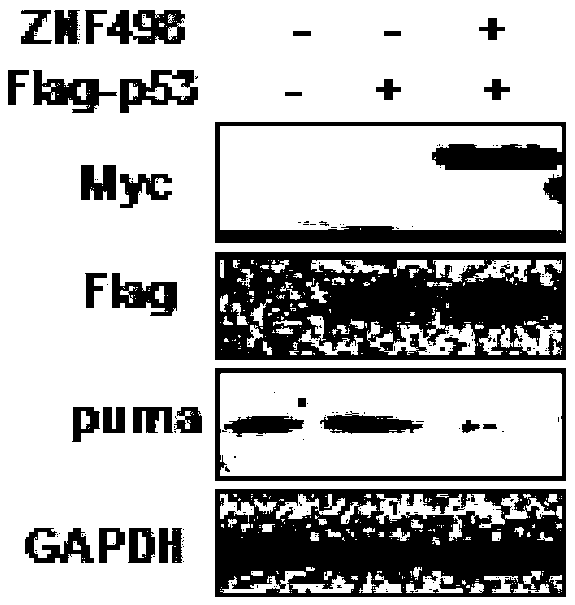Application of ZNF498 protein expression quantity inhibiting substance in preparing cancer preventing and treating products
A technology of expression quantity and protein, applied in the field of biomedicine
- Summary
- Abstract
- Description
- Claims
- Application Information
AI Technical Summary
Problems solved by technology
Method used
Image
Examples
Embodiment 1
[0093] Embodiment 1, the construction of plasmid, the preparation of oligonucleotide and the acquisition of HepG2 shRNA-ZNF498 cell
[0094] 1. Construction of Myc-ZNF498 plasmid
[0095] The small fragment between the recognition sequences of the restriction endonucleases EcoRI and XhoI of the pCMV-Myc plasmid was replaced with the DNA molecule shown in sequence 2 in the sequence listing, and the resulting recombinant plasmid was the Myc-ZNF498 plasmid.
[0096] The Myc-ZNF498 plasmid expresses the ZNF498 protein shown in Sequence 1 in the Sequence Listing.
[0097] 2. Construction of Flag-p53 plasmid
[0098] The small fragment between the recognition sequences of the restriction endonucleases EcoRI and BamHI of the pCMV-Flag plasmid is replaced with the DNA molecule shown in sequence 4 in the sequence table, and the resulting recombinant plasmid is the Flag-p53 plasmid.
[0099] The Flag-p53 plasmid expresses the p53 protein shown in sequence 3 in the sequence listing.
...
Embodiment 2
[0120] Example 2, ZNF498 protein can inhibit endogenous p53 protein activity
[0121] Experiment 1. ZNF498 protein can inhibit the transcriptional activity of endogenous p53 protein
[0122] The experiment was repeated three times to take the average value, and the steps for each repetition were as follows:
[0123] 1. Convert p53 + / + HepG2 cells were seeded in 12 wells of a 24-well plate containing 0.5 mL of DMEM medium (4.0 × 10 4 cells), and then placed at 37°C, 5% CO 2 Cultivate in an incubator, and when the fusion rate reaches 70-90%, they are randomly divided into four groups, and each group is set with three replicate wells, and the following treatments are carried out:
[0124] The first group: add 20ng pG13L plasmid, 0.2ng pRL-TK plasmid and 0.4μg pCMV-Myc plasmid to each well, and co-transfect for 36h.
[0125] The second group: add 20ng pG13L plasmid, 0.2ng pRL-TK plasmid, 0.3μg pCMV-Myc plasmid and 0.1μg Myc-ZNF498 plasmid to each well, and co-transfect for 36h...
Embodiment 3
[0150] Embodiment 3, inhibit the expression of ZNF498 protein and increase the expression level of Puma protein
[0151] Experiment 1: After inhibiting the expression of ZNF498 protein, the expression levels of Puma protein and Gadd45 protein were increased
[0152] The experiment was repeated three times to take the average value, and the steps for each repetition were as follows:
[0153] 1. Convert p53 + / + HepG2 cells were seeded in 3 wells of a 24-well plate containing 0.5 mL DMEM medium (4.0 × 10 4 cells), and then placed at 37°C, 5% CO 2 Cultivate in an incubator, and when the fusion rate reaches 70-90%, proceed as follows:
[0154] The first well: add 0.5 μg siRNA-con, and co-transfect for 36 hours;
[0155] The second well: add 0.5 μg siRNAa, and co-transfect for 36 hours;
[0156] The third well: add 0.5 μg siRNAb, and co-transfect for 36 hours.
[0157] 2. After completing step 1, extract the total protein of each cell, and perform Western Blot with Puma antibo...
PUM
 Login to View More
Login to View More Abstract
Description
Claims
Application Information
 Login to View More
Login to View More - Generate Ideas
- Intellectual Property
- Life Sciences
- Materials
- Tech Scout
- Unparalleled Data Quality
- Higher Quality Content
- 60% Fewer Hallucinations
Browse by: Latest US Patents, China's latest patents, Technical Efficacy Thesaurus, Application Domain, Technology Topic, Popular Technical Reports.
© 2025 PatSnap. All rights reserved.Legal|Privacy policy|Modern Slavery Act Transparency Statement|Sitemap|About US| Contact US: help@patsnap.com



